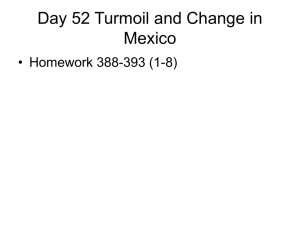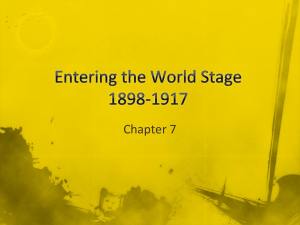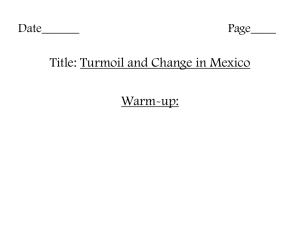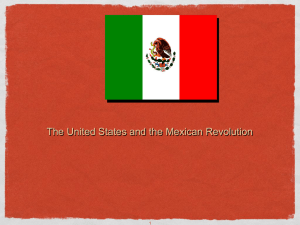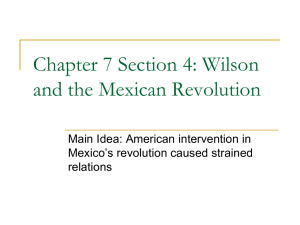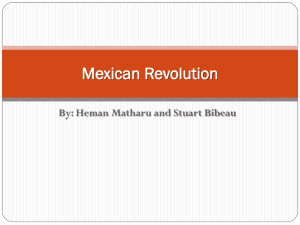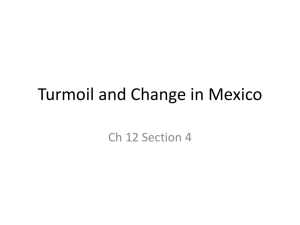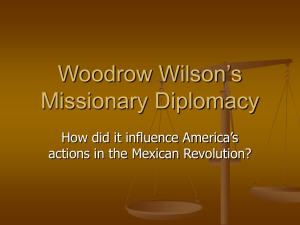WHAP Ch 32: The Mexican Revolution
advertisement
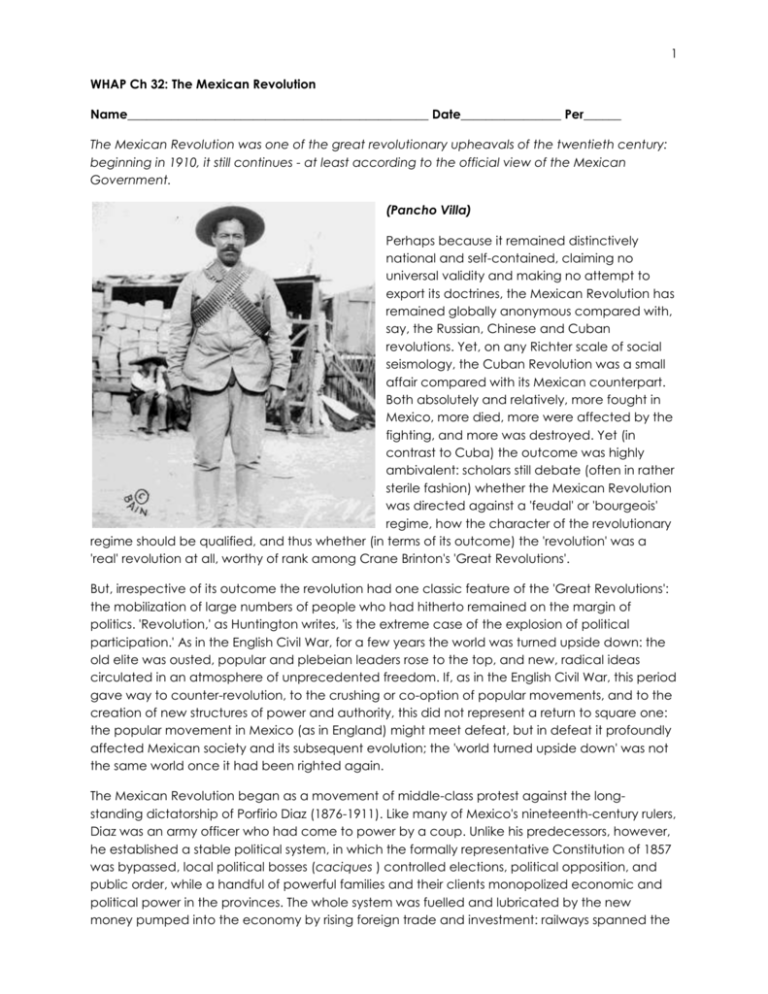
1
WHAP Ch 32: The Mexican Revolution
Name________________________________________________ Date________________ Per______
The Mexican Revolution was one of the great revolutionary upheavals of the twentieth century:
beginning in 1910, it still continues - at least according to the official view of the Mexican
Government.
(Pancho Villa)
Perhaps because it remained distinctively
national and self-contained, claiming no
universal validity and making no attempt to
export its doctrines, the Mexican Revolution has
remained globally anonymous compared with,
say, the Russian, Chinese and Cuban
revolutions. Yet, on any Richter scale of social
seismology, the Cuban Revolution was a small
affair compared with its Mexican counterpart.
Both absolutely and relatively, more fought in
Mexico, more died, more were affected by the
fighting, and more was destroyed. Yet (in
contrast to Cuba) the outcome was highly
ambivalent: scholars still debate (often in rather
sterile fashion) whether the Mexican Revolution
was directed against a 'feudal' or 'bourgeois'
regime, how the character of the revolutionary
regime should be qualified, and thus whether (in terms of its outcome) the 'revolution' was a
'real' revolution at all, worthy of rank among Crane Brinton's 'Great Revolutions'.
But, irrespective of its outcome the revolution had one classic feature of the 'Great Revolutions':
the mobilization of large numbers of people who had hitherto remained on the margin of
politics. 'Revolution,' as Huntington writes, 'is the extreme case of the explosion of political
participation.' As in the English Civil War, for a few years the world was turned upside down: the
old elite was ousted, popular and plebeian leaders rose to the top, and new, radical ideas
circulated in an atmosphere of unprecedented freedom. If, as in the English Civil War, this period
gave way to counter-revolution, to the crushing or co-option of popular movements, and to the
creation of new structures of power and authority, this did not represent a return to square one:
the popular movement in Mexico (as in England) might meet defeat, but in defeat it profoundly
affected Mexican society and its subsequent evolution; the 'world turned upside down' was not
the same world once it had been righted again.
The Mexican Revolution began as a movement of middle-class protest against the longstanding dictatorship of Porfirio Diaz (1876-1911). Like many of Mexico's nineteenth-century rulers,
Diaz was an army officer who had come to power by a coup. Unlike his predecessors, however,
he established a stable political system, in which the formally representative Constitution of 1857
was bypassed, local political bosses (caciques ) controlled elections, political opposition, and
public order, while a handful of powerful families and their clients monopolized economic and
political power in the provinces. The whole system was fuelled and lubricated by the new
money pumped into the economy by rising foreign trade and investment: railways spanned the
2
country, mines and export crops flourished; the cities acquired paved streets, electric light, trams
and drains. These developments were apparent in other, major Latin American countries at the
time. But in Mexico they had a particular impact, and a unique, revolutionary outcome, The
oligarchy benefited from its liaison with foreign capital: Luis Terrazas, a butcher's son, rose to
dominate the northern state of Chihuahua, acquiring huge cattle estates, mines and industrial
interests, and running the politics of the state to his own satisfaction; the sugar planters of the
warm, lush state of Morelos, near the capital, imported new machinery, hoisted production, and
began to compete on world markets (they could also holiday at Biarritz and buy foreign luxury
goods - whether French porcelain or English fox-terriers); Olegario Mohna ran the economy and
politics of Yucatan, where his son-in-law handled the export of henequen,' the state's basic crop,
and, among his many lesser relatives and clients, a second cousin was Inspector of Mayan Ruins
(he had never visited Chichen Itza, he told two English travelers, but 'had satisfactory
photographs').
Money also bolstered the national government. The perennially precarious budget was
stabilized in the 1890s and Mexico's credit rating was the envy of Latin America. In 1910, when
the ageing dictator played host to the world's representatives on the occasion of the hundredth
anniversary of Mexico's independence, peace and prosperity seemed assured.
Within six months, Diaz was overthrown and Mexico had entered upon a decade of fierce civil
strife. Two groups - dissimilar and often antagonistic - combined to oust Diaz. First, in Mexico as
elsewhere in Latin America, the expansion of both the state and the economy in the late
nineteenth century helped promote the growth of a vigorous, educated, urban middle class:
teachers, lawyers, clerks and officials, small businessmen and merchants. Many had profited
from the Porfirian economic miracle; but they resented both the continued dominance of the
provincial oligarchies (based largely on landed wealth) and the unchanging, unresponsive
national dictatorship (based ultimately on military force). More specifically, they chafed at
political restrictions (the arbitrary courts, rigged elections and controlled press). They harked
back to the liberal heroes of Mexico's past, and made comparisons with the flourishing liberal
democracies of Europe and North America. Finally, they feared for Mexico's (and their own)
future if Diaz died politically intestate, without bequeathing to the nation a form of viable,
representative government. Accordingly, they readily responded to the appeal of Francisco
Madero, a rich northern landowner and businessman who - more out of idealism than naked
self-interest - began to campaign for a stricter implementation of the 1857 Constitution, which
was still chiefly honored in the breach. 'Sufragio Efectivo, No Re-eleccion ' ('A Real Vote and No
Boss Rule') was the slogan of Madero and his Anti-re-electionist Party, and their political
campaigns of 1909-10 were characterized by vigorous journalism, mass meetings and whistlestop tours all the paraphernalia of the North American democracy which they sought to
emulate. Initially complacent, Diaz was rattled by the mounting political agitation. On the eve of
the 1910 presidential election (in which Madero opposed Diaz: most of the family agreed with
grandfather Evaristo Madero's dismissive comment that this resembled 'a microbe's challenge to
an elephant') Madero and his close allies were gaoled, and the election was conducted
according to the usual principles of corruption and coercion. Diaz won.
Madero was expected to take note and return, suitably chastened, to his northern estates. Most
of his followers educated, middle-aged, frock-coated liberals did return to their classrooms,
companies and law firms. They could make good speeches and pen elegant articles, but more
was beyond them. An armed revolt? 'It was dangerous,' they agreed when they discussed the
matter in Yucatan. 'Nobody was partisan of shedding blood and, even if everybody had been
so, there was no money, time, nor people expert in a movement of that sort.' So thought most
3
Maderistas. Not so Madero. Small, quirky, mild-mannered, and something of a political naif,
Madero had a generous belief in the good sense and reason of the people (just as he believed
in spiritualism and the virtues of homoeopathic medicine). Rather than capitulate to Diaz,
Madero called upon the Mexican people to rise in arms on November 20th, 1910.
The appeal enjoyed sudden, surprising success because it struck a chord with a second group,
the illiterate rural mass, the Indians and mestizos (half-castes) of village and hacienda, who
formed the bulk of Mexico's population, who provided the labor upon which the economy
rested, but who lived, impotent and often ignored, on the margin of political life. It was not that
they - like Madero and the city liberals - were enamored of liberal abstractions and foreign
examples: for them, 'A Real Vote and No Boss Rule' had a more concrete, particular and
compelling significance. Under Diaz, the economy and the state had grown apace; but these
processes, as is often the case, had had divergent effects, and the countryside, particularly the
rural poor, had carried the burden of Diaz's program of modernization. While the cities
prospered, the great estates swelled to meet world and Mexican demand for primary products
(sugar, cotton, coffee, henequen, tropical fruits), absorbing the lands of villages and
smallholders, converting once independent peasants into landless laborers, who often worked
under harsh overseers. As the old cornfields gave way to new cash crops, so food became more
scarce and prices rose, outstripping wages. In some parts of Mexico a form of virtual slavery
developed; and, in years of poor harvests, like 1908-09, the rural poor faced real destitution. With
the monopolization of land in the hands of landlords and caciques went a corresponding
monopolization of political power, and proud, often ancient communities found themselves
languishing under the arbitrary rule of Diaz's political bosses, facing increased control,
regimentation and taxation.
In Morelos, entire villages vanished beneath a blanket of sugar-cane. In Sonora, in the northwest, the Federal army fought a series of bitter campaigns to dispossess the Yaqui Indians of their
ancestral lands. Smallholders like the Cedillo family of Palomas, in the state of San Luis, battled
against hacienda encroachments on their land. Villages petitioned (usually in vain) against the
rule of caciques like Luz Comaduran of Bachiaiva, in the Chihuahua highlands, where municipal
land had been expropriated by the cacique and his clients, where four thugs were employed to
silence opposition, and where Comaduran's period in office comprised 'years of noose and knife
... involving the abuse of all laws, both municipal and civil, human and divine'. For such people,
Madero's revolution held out the prospect, less of a progressive liberal polity, inspired by
Gladstone or Gambetta, than of the recovery of local freedoms, the reconquest of village lands,
the overthrow of tyrannical bosses and landlords. Their vision was nostalgic, particular and
powerful: they sought to recover the world they had lost, or were fast losing.
To general surprise, and to the government's consternation, local armed bands sprang up during
the winter of 1910-11, first in northern then central Mexico. Diaz's rusty military apparatus proved
unable to contain the spread of guerrilla warfare and, in May, 1911, his advisers prevailed upon
him to resign, in the hope - well-founded as it turned out - that they could salvage something
before the revolution proceeded too far. Six months later Madero was inaugurated president,
following the freest election ever held in the country's history.
The subsequent years were violent and chaotic. Madero's liberal experiment failed. Adherents of
the old regime - landowners, the military, top businessmen and clerics -blocked his modest
reforms; and the latter came too slowly to satisfy the popular elements which had brought
Madero to power in the first place. Caught in this crossfire, Madero was finally overthrown by the
army and assassinated early in 1913; but the establishment of a draconian military regime under
4
General Victoriano Huerta, a regime dedicated to 'peace, cost what it may' and to the
substantial restoration of the old regime, only guaranteed the galloping inflation of popular
rebellion. The people fought on, and the militarist solution, attempted to the limit in 1913-14,
proved as naive and impractical as the liberal solution had in 1911-12. Meantime, during
eighteen months of fierce fighting, which culminated in the fall of Huerta, the fabric of the old
order was irretrievably rent: the Porfirian army, the local bosses, the state oligarchies, the church
and the bureaucracy were forced to surrender much or all of their power.
Who ruled Mexico in their place? For a time, in many localities, power had shifted into the hands
of popular leaders, the bushwhackers and guerrilleros who had fought first Diaz, then Huerta. The
two most famous and powerful were Emiliano Zapata and Francisco ('Pancho') Villa, who
typified, in many respects, the main characteristics of the popular movement. Zapata led the
villagers of Morelos in a crusade to recover the lands lost to the sugar estates, and from this
objective he never swerved. Though city intellectuals later tagged along, writing his official
communications and mouthing a bastard socialism, Zapata himself remained a man of the
people, indifferent to formal ideologies, content with a traditional Catholicism, fiercely loyal to
his Morelos followers, as they were to him. City politicians who attempted a dialogue with
Zapata found him (like many of his kind) intractable: he was too cerrado too close uncommunicative, dour, suspicious and alien to compromise. At home, in rural Morelos, Zapata
cut the figure of a charro , a horse-loving, dashing, somewhat dandified countryman, who
affected huge sombreros, tight silver- buttoned trousers, and shirts and scarves of pastel shades,
who preferred to spend his time at cockfights, breaking horses, sipping beer in the plaza or
fathering children. Underpinned by the mutual trust of leader and led, Zapata's forces - despite
their inadequate arms - dominated the state of Morelos for years, repeatedly confounding
superior conventional armies. But, though Zapata forged alliances with neighboring rebels, his
horizons remained limited. When his troops occupied Mexico City late in 1914, Zapata slunk off to
a seedy hotel near the station. Unlike Marlon Brando's Zapata - in the Kazan classic, Viva Zapata!
- he never occupied the presidential chair; indeed, he never much wanted to. Its deep local
roots provided both the strength and weakness of the Zapatista movement.
It was just outside Mexico City, late in 1914, that Zapata and Villa, the great rebel chiefs of south
and north, met for the first time: Zapata, slim, dark and dandified; Villa, 'tall, robust, weighing
about 180 pounds, with a complexion almost as florid as a German, wearing an English [pith]
helmet, a heavy brown sweater, khaki leggings and heavy riding shoes'. Neither was very
communicative: they eyed each other coyly 'like two country sweethearts'; and, when Zapata,
who liked his drink, ordered cognac, Villa, who did not take hard liquor, drank only to oblige,
choked, and called for water. But they shared and they soon found out that they shared a
common viewpoint, as they began running down the nominal leader of their revolution, the
staid, elderly, ponderous and somewhat pedantic Venustiano Carranza.
Though their appearances were in marked contrast, and though their respective armies differed
in important respects - Villa's, recruited from the villages and cattlespreads of the north, was a
more professional, mobile force, which had destroyed Huerta's Federal army in its dramatic
descent on the capital - nevertheless, the two caudillos shared a common popular origin and
popular appeal. Villa, a peasant's son driven to banditry, had become a devoted follower of
Madero, and now robbed the rich and righted wrongs on a grand scale. He had no clear-cut
agrarian cause, like Zapata; and his political grasp was no keener. But he had a knack for
guerrilla fighting, and carried over his verve and charisma into the conventional campaigns of
1914, when the massed charges of the Villista cavalry shattered the Federals. With north and
central Mexico in his palm, Villa ran unpopular landlords and bosses out of the country (the
5
Terrazas clan were his chief victims) and distributed their property in careless fashion to friends
and followers. He handed out free food to the poor and (his supporters said) established free
education.
Though his army grew and acquired many of the accoutrements of modern war -artillery, a
hospital train, an efficient commissary - Villa, like Zapata, never lost touch with the common
people who, in good times and bad, lent him their support. He still preferred popular pastimes impromptu bullfights and all-night dances, after which Villa would arrive at the front 'with
bloodshot eyes and an air of extreme lassitude'. Though he avoided hard liquor (this, like his
rheumatism, was a legacy of his bandit days) he womanized freely. And, though a general, he
mixed readily with the rank and file, swapping jokes on the long, disorganized railway journeys
which took his army and their camp-followers, like some huge folk migration, from the northern
border down to Mexico City, Villa himself travelling in 'a red caboose with chintz curtains and...
photographs of showy ladies in theatrical poses tacked on the walls'. In battle Villa was always in
the thick, urging on his men, rather than directing strategy from the rear.
Over the years, however, popular movements of this kind gradually lost their impetus. Defeated,
or simply war-weary, the soldiers returned to village and hacienda; the surviving leaders (who
were few enough) reached deals or accommodations with the new 'revolutionary' government.
So it was all over Mexico, as a semblance of peace was established late in the decade. By a
strange irony, none of the original protagonists of the civil war achieved ultimate success: Diaz
and Huerta, the champions of the old régime, failed to contain the forces of change and
rebellion; but the rebels, too, both the pioneer city liberals and the popular forces of the countryside, proved unable (in the first case) and unwilling (in the second) to fasten their control on the
country.
A fourth power stepped into the vacuum: labeled the Constitutionalists, because of their
supposed attachment to constitutional rule, they were in fact sharp opportunists, men of the
northern states, particularly of the prosperous, Americanized state of Sonora. They were not
grand hacendados or suave intellectuals; but neither were they rural hicks, tied to the ways of
the village and the cycle of the agricultural year. They moved equally in city and countryside: if
they farmed (as their greatest military champion, Alvaro Obregon, did) they were go-ahead,
entrepreneurial farmers; or, like their greatest political fixer, Plutarco Elias Calles, they may have
drifted from job to job school- teacher, hotelier, municipal official acquiring varied experience
and an eye for the main chance. Though they lacked a classical education, they were literate,
and often endowed with practical skills; and, though they had no deep roots in local
communities (indeed, their very footloose mobility was one of their great assets in (he struggle for
power) they saw and accepted - as neither Diaz nor Madero nor Huerta had done - that the
post- revolutionary regime needed some kind of popular base. The masses who had fought in
the revolution could not simply be repressed; they would have to be bought off too.
For the Constitutionalists, this was often a cynical process. The distribution of land to the villages
was for them a political maneuver not - as with Zapata - an article of faith. It was a means to
quiet and domesticate the troublesome rural population, turning them into loyal subjects of the
revolutionary state. And the common touch which Constitutionalist generals like Obregon
cultivated was - however skilled and effective - not quite the genuine rapport which Villa,
Zapata, or Contreras had shared with their followers. But, artificial and self-seeking though
Constitutionalist methods were, they worked. Where Madero had failed to hold national power,
and neither Villa nor Zapata had seriously tried, the Constitutionalists were ready, willing and
able. They were militarily able: in the final, decisive bout of civil war in 1915 Obregon
6
comprehensively defeated Villa in a series of similar engagements. The massed charges of the
Villista cavalry, successful against Huerta's reluctant conscripts, failed bloodily and ignominiously
when the Division of the North confronted an army of mettle and organization, and when Villa
came up against a shrewd, scientific (albeit self-taught) general like Obregon, who had learned
and applied the lessons of the Western Front.
Whipped, Villa retired to Chihuahua and reverted to semi-bandit status, raiding towns and
villages with apparent impunity, still able to count on local support, and defying both the
Mexican and the American forces sent to hunt him down. This was his natural habitat and
metier. Zapata, too, continued his guerrilla war in Morelos until, in 1919, he met the usual fate of
the popular champion and noble robber: invulnerable to direct attacks, he was lured into a trap
and treacherously killed. Other popular leaders went the same way. Villa survived his old ally by
four years. With a semblance of peace restored, and Obregon installed in the presidency, Villa
was amnestied by his old conqueror and granted a large estate where he and his ageing
veterans might live out their declining years. But Villa had many vengeful enemies; and the
central government, notwithstanding its amnesty, feared a possible revival of the old caudillo in
the north. In July, 1923 Villa was gunned down as he drove through the streets of Parral.
Most of his lieutenants had gone years before: Ortega, dead of typhoid after the battle of
Zacatecas; Urbina, executed at Villa's own orders for insubordination; Fierro, drowned in a
quicksand during the Villista retreat of 1915. And what of those popular leaders who, against the
odds, survived? The qualities which made Villa, Zapata, Contreras and others revolutionaries
and guerrilla fighters often disqualified them from subsequent political careers: they were too
provincial, ill-educated, wedded to a traditional, rural way of life which, in many respects, was
on the way out.
The future belonged to nationally-minded, citified operators: not Madero's refined liberals, but
the sharp, self-made men of Sonora, or at least men cast in their image -like Nicolas Zapata, son
of the revolutionary, who acquired land, wealth and power in Morelos, having 'learned the
rudiments of politics - which rotted his sense of obligation' to the local community. Nicolas
Zapata was of the post-revolutionary generation as a nine-year-old he had slept through his
father's famous meeting with Villa. Of the original generation of popular revolutionaries, some
found a place in the new regime, not least because it was to the regime's advantage, while a
few assimilated successfully.
But such willing and successful transformations were rare. More often, popular leaders who
survived the fighting only adapted imperfectly and with reluctance. The new world was not to
their liking; it was certainly not what they and their followers had fought for. Saturnino Cedillo
outlived his brothers and became governor and state boss of San Luis. He did well by his old
supporters, settling them on lands in the state, but he could not altogether fathom the ways of
new, post-revolutionary regime. For Cedillo, the complexity of modern politics, the labor of
administration and the conflict of rival ideologies were - in 1938, as twenty years before - to be
shunned: 'he hated the whole business; you could see he didn't think in our terms at all... he had
been happier at sunset, jolting over the stony fields in an old car, showing off his crops'. Within
weeks, Cedillo had been goaded into rebellion by the central government, driven into the hills,
hunted down with planes, and finally killed. The Cedillo 'revolt' (as the government chose to call
it) was the last kick of the good old cause, final proof that the popular revolutionary movement
had passed into history. It survives only in the myths, murals and revolutionary rhetoric of modern
Mexico.
7
